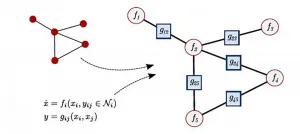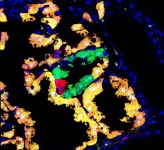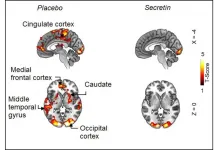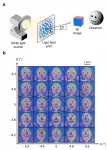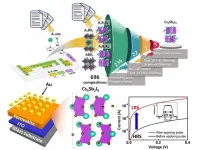(Press-News.org) WASHINGTON, June 22, 2021 -- Emerging open-source programming language Julia is designed to be fast and easy to use.
Since it is particularly suited for numerical applications, such as differential equations, scientists in Germany are using it to explore the challenges involved in transitioning to all-renewable power generation.
Decarbonization implies a radical restructuring of power grids, which are huge complex systems with a wide variety of constraints, uncertainties, and heterogeneities. Power grids will become even more complex in the future, so new computational tools are needed.
In Chaos, from AIP Publishing, Potsdam Institute for Climate Impact Research (PIK) scientists describe a software package they built to enable the simulation of general dynamical systems on complex networks.
They wanted to build an open-source tool -- so anyone can verify its software structure and algorithms -- to make all state-of-the-art algorithms within Julia's ecosystem easily accessible to engineers and physicists. Their package, called NetworkDynamics.jl, started out as the computational backend of another one, PowerDynamics.jl.
"We realized our computational backend would be useful to other researchers within the dynamical systems community as well," said Michael Lindner, a postdoctoral researcher at PIK.
The two theoretical pillars of their work are differential equations and complex networks.
"By casting models of power grids or brains, for example, in terms of differential equations on networks, we give them a clear underlying structure," he said. "The network encodes locality, what interacts with what, and the differential equations encode dynamics, how things change with time."
This enables researchers to obtain state-of-the-art simulation speeds.
"We first compute all the interactions among network components, then the back reactions of individual components to that interaction. This allows us to compute the entire evolution of the system within two easily parallelizable loops," said Lindner.
Since Julia is fast and easy to write and has a library for solving differential equations (DifferentialEquations.jl), researchers can implement and simulate complicated models within one day -- rather than the month it used to require with other languages.
"It removes some of the barriers limiting scientific creativity," Lindner said. "I hadn't even thought about certain models and important questions before, just because they seemed completely out of reach with my given time constraints and programming skills."
A good, intuitive interface to high-performance algorithms is "important for science today," he said, "because they enable scientists to focus on their research questions and models instead of code and implementation details."
INFORMATION:
The article, "NetworkDynamics.jl - Composing and simulating complex networks in Julia," is authored by Michael Lindner, Lucas Lincoln, Fenja Drauschke, Julia M. Koulen, Hans Würfel, Anton Plietzsch, and Frank Hellmann. It will appear in Chaos on June 22, 2021 (DOI: 10.1063/5.0051387). After that date, it can be accessed at https://aip.scitation.org/doi/10.1063/5.0051387.
ABOUT THE JOURNAL
Chaos is devoted to increasing the understanding of nonlinear phenomena in all areas of science and engineering and describing their manifestations in a manner comprehensible to researchers from a broad spectrum of disciplines. See https://aip.scitation.org/journal/cha.
WASHINGTON, June 22, 2020 -- Most models explaining how viruses are transmitted focus on viral particles escaping one person to infect a nearby person. A study on the role of microscopic particles in how viruses are transmitted suggests pollen is nothing to sneeze at.
In Physics of Fluids, by AIP Publishing, Talib Dbouk and Dimitris Drikakis investigate how pollen facilitates the spread of an RNA virus like the COVID-19 virus. The study draws on cutting-edge computational approaches for analyzing fluid dynamics to mimic the pollen movement from a willow ...
Genetic mosaic individuals, which contain cells of different genotypes, arise naturally in multicellular organisms. In humans, the development of cancer - where one cell acquires a mutation that allows it to proliferate, while other cells don't - is a prime example of genetic mosaicism. But inversely, genetic mosaicism can be used to study and understand the development of disease.
A common quirk of nature used to understand genes
One experimental genetic mosaic approach is called Mosaic Analysis with Double Markers (MADM), in which genes are mutated in individual cells while, at the same time, the mutated cells are labelled in fluorescent colors. ...
Scientists at Nagoya University, with colleagues at Kyoto University in Japan, have uncovered a mechanism that allows a protein complex to bind to DNA without impeding some of the important processes of cell division. Their findings, published in the journal Cell Reports, could further understandings of developmental disorders arising from mutations in the gene that codes for the complex.
DNA condenses during cell division to form structures called chromosomes that are formed of two identical copies, called sister chromatids. These sister chromatids are bound together by proteins called cohesins, until it is time for them to be pulled apart and directed into the newly formed cells. Scientists know quite a bit about the ...
The venom of a caterpillar, native to South East Queensland, shows promise for use in medicines and pest control, Institute for Molecular Bioscience researchers say.
The Doratifera vulnerans is common to large parts of Queensland's south-east and is routinely found in Toohey Forest Park on Brisbane's southside.
Dr Andrew Walker has been researching the striking looking caterpillar since 2017.
"We found one while collecting assassin bugs near Toowoomba and its strange biology and pain-causing venom fascinated me," Dr Walker said.
Unlike The Very Hungry Caterpillar that charmed generations of children around ...
"Detecting primordial black holes opens up new perspectives to understand the origin of the Universe, because these still hypothetical black holes are supposed to have formed just a few tiny fractions of a second after the Big Bang. Their study is of great interest for research in theoretical physics and cosmology, because they could notably explain the origin of dark matter in the Universe". You can see stars in the eyes of the members of the team led by Professor Fuzfa, astrophysicist at UNamur, when talking about the perspectives of their research. This project is the result of an unprecedented collaboration between the UNamur ...
Researchers from the Turku PET Centre and Technical University of Munich have discovered a new mechanism controlling satiation. According to the recently published study, the hormone secretin induces satiation by activating brown adipose tissue.
Brown adipose tissue is known for its ability to generate heat in response to cold exposure. Its activity has been proven to be connected to normal weight and glucose metabolism as well as lesser risks of cardiovascular diseases. Meals have also been shown to increase the thermogenesis in brown fat, but the significance of this phenomenon has been unclear. ...
Teacher training students who practised teaching virtual pupils developed greater confidence in their teaching ability, according to a study from Linköping University. In the long term, simulation can make the students better prepared for their workforce debut.
Teacher training programmes often have difficulty offering their students sufficient teaching practice for their future profession. Many teaching graduates feel unprepared when they start working, and some decide to change career path, despite good employment prospects caused by a teacher shortage.
A group of researchers at Linköping University investigated whether teaching virtual pupils could make teacher training students better prepared for teaching in a real classroom.
"By ...
Wouldn't it be amazing if printed images can look three-dimensional (3D)? Unfortunately, conventional prints like photographs display two-dimensional (2D) images with a fixed appearance as they contain only intensity and colour information. These prints are unable to display a 3D image because they lack directional control of light rays, hence resulting in the loss of depth information.
To address this problem, a team of researchers from the Singapore University of Technology and Design (SUTD) used a nanoscale 3D printing technique to create high-resolution light field prints ...
A research team led by Professor Jang-Sik Lee of Pohang University of Science and Technology (POSTECH) has successfully developed the halide perovskite-based memory with ultra-fast switching speed. The findings from this study were published in Nature Communications on June 10, 2021.
Resistive switching memory is a promising contender for next-generation memory device due to its advantages of simple structure and low power consumption. Various materials have been previously studied for resistive switching memory. Among them, halide perovskites are receiving much attention for use in the memory because of low operation voltage and high on/off ratio. However, halide perovskite-based ...
People who have contact with other social groups are more likely to be committed to social justice. However, an international study led by the University of Zurich has shown that for this to be the case, power relations and discrimination must be actively addressed and group-specific needs must be met. It is important that disadvantaged group members, such as racial minorities and LGBTIQ+ individuals, are given a voice, and that those who belong to advantaged groups do not feel labeled as biased.
People who are socially disadvantaged or discriminated against because they belong to a particular group often join forces with other disadvantaged people to fight together for better rights. Prominent examples of such political engagement are the women's rights movement, Black Lives ...
